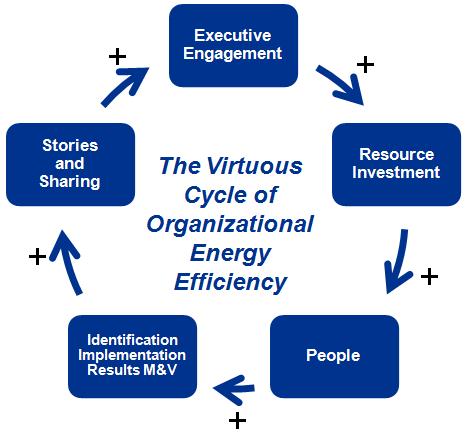Scott Wentzell | May 30, 2013
By: Scott Wentzell
Earlier this month, Environmental Defense Fund (EDF) and MIT co-hosted a workshop at GreenBiz’s VERGE Boston on best practices in organizational energy efficiency. Jason Jay, Director of the MIT Sloan Initiative for Sustainable Business and Society, moderated the discussion. Representatives from Genzyme and Nixon Peabody joined EDF’s Victoria Mills as panelists.
Jay challenged audience members to think of their own organizations and pinpoint where they currently sit on the road to energy efficiency. He asked them to view their own organizational challenges through the lens of the Virtuous Cycle of Organizational Energy Efficiency model developed by EDF and MIT.
This Virtuous Cycle model was born out of EDF’s work with hundreds of leading organizations striving to reduce energy use and cut costs through EDF Climate Corps. It is a model of change we've found to apply to energy efficiency success across even radically different organizations with five powerful, interdependent components (pictured below).

Learn more about the Virtuous Cycle model on our Web site.
The Virtuous Cycle at Genzyme
Jeff Holmes, principal engineer at Genzyme, detailed his journey to set site-specific greenhouse gas reduction targets for the company. He said once the targets were set, he gave site managers a great deal of freedom to meet targets and created strong incentives by building energy reduction goals directly into budgets. When viewed through the lens of the Virtuous Cycle, it is clear that in this case executive buy-in precipitated new financial incentives and employee initiatives to drive energy efficiency. These factors all combined to propel Genzyme around the Virtuous Cycle to further energy efficiency efforts.
The Virtuous Cycle at Nixon Peabody
Carolyn Kaplan is the chief sustainability officer at Nixon Peabody, a law firm with 17 offices nationwide and over 1,400 employees. She shared her strategy of focusing on low- and no-cost projects upfront to demonstrate success and build the interest and support needed to ultimately make the financial case for larger projects. This example shows how sharing stories of preliminary successes can pave the way for the executive buy in that will help propel an organization around the Virtuous Cycle.
Insights from Participants
The session largely consisted of energy efficiency practitioners from a variety of different organizations, so Jay asked participants to divide up according to components of the Virtuous Cycle, thinking about which component of the model represented the largest barrier for their specific organizations. I joined the Resource Investment group. Here are my takeaways:
- Common Barrier: Organizations set strict pay-back period limits on capital projects that make it very hard to implement serious energy efficiency projects.
- Common Barrier: Energy efficiency projects often compete for capital against other projects that are more aligned with the organization’s mission.
- Creative Solutions: There are many alternative financing pathways for energy efficiency such as Energy Service Agreements, equipment leasing, rebates and incentives. We also discussed revolving sustainability funds which reap the cost savings of initial projects to use as seed capital for future projects. In addition, the group agreed that energy efficiency is much easier to implement during new construction and retrofitting, so it is important to make sure energy efficiency opportunities are identified at the onset of any construction or renovation project.
Do you have a best practice you’d like to share or a barrier you’d like to overcome related to the Virtuous Cycle? Let us know in the comments below.
About EDF Climate Corps
EDF Climate Corps (edfclimatecorps.org) taps the talents of tomorrow’s leaders to save energy, money and the environment by placing specially-trained EDF fellows in companies, cities and universities as dedicated energy problem solvers. Working with hundreds of leading organizations, EDF Climate Corps has found an average of $1 million in energy savings for each participant. For more information, visit edfclimatecorps.org. Read our blog at edfclimatecorps.org/blog. Follow us on Twitter at twitter.com/edfbiz and on Facebook at facebook.com/EDFClimateCorps.